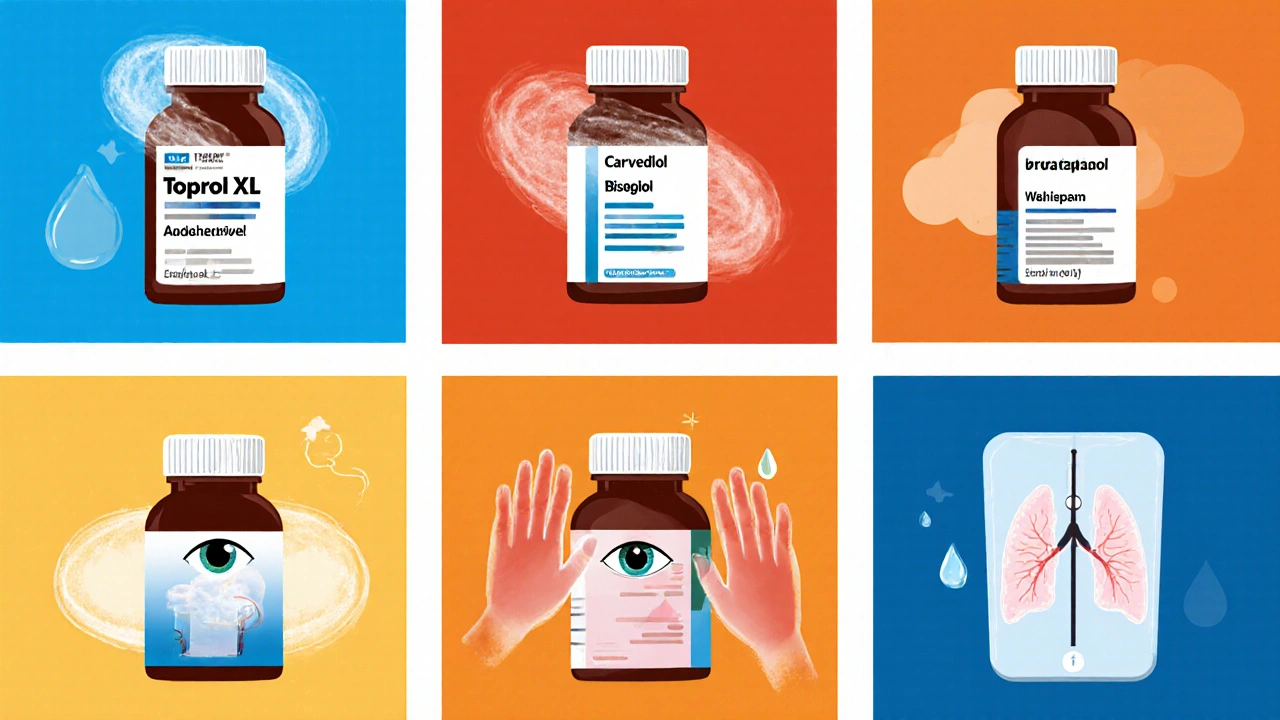When your doctor prescribes Toprol XL for high blood pressure or heart disease, you might wonder if there’s a better fit for your lifestyle, budget, or side‑effect tolerance. This guide breaks down what makes Toprol XL (metoprolol succinate) unique, pits it against the most‑prescribed alternatives, and gives you a clear checklist to discuss with your clinician.
What Is Toprol XL (Metoprolol)?
Toprol XL is a extended‑release beta‑1 selective blocker that slows heart rate, reduces the force of contraction, and lowers blood pressure. Its generic name, Metoprolol succinate, was approved by the FDA in 1995 and is widely used for:
- Hypertension (high blood pressure)
- Stable angina
- Heart failure with reduced ejection fraction
- Post‑myocardial infarction (heart attack) management
The drug’s 24‑hour release allows once‑daily dosing, which improves adherence compared with immediate‑release versions that require twice‑daily administration.
Why Look for Alternatives?
Even a well‑tolerated medication can clash with other health conditions, interact with new prescriptions, or strain your wallet. Common reasons patients explore other options include:
- Persistent side effects such as fatigue, cold hands, or sexual dysfunction
- Need for a non‑selective beta blocker (e.g., for migraine prophylaxis)
- Contraindications like severe asthma or certain forms of heart block
- Insurance formulary changes that make Toprol XL expensive
Switching isn’t a decision you make alone-your cardiologist or primary‑care physician should weigh the clinical trade‑offs.
Common Alternatives to Toprol XL
Below are the most frequently prescribed drugs that can replace or complement Toprol XL. Each entry includes the drug’s class, typical dose range, and one clinical nuance.
- Atenolol - a beta‑1 selective blocker; often chosen for patients who need a shorter half‑life (6‑8hours). Typical dose: 25-100mg once daily.
- Carvedilol - a non‑selective beta blocker with alpha‑1 blocking activity; useful in heart failure because it also reduces afterload. Typical dose: 3.125-25mg twice daily.
- Bisoprolol - another beta‑1 selective agent; praised for its once‑daily dosing and lower incidence of bronchospasm. Typical dose: 2.5-10mg once daily.
- Propranolol - a classic non‑selective beta blocker; treats hypertension, migraine, and essential tremor but can worsen asthma. Typical dose: 40-160mg divided 2-3 times daily.
- Lisinopril - an ACE inhibitor, not a beta blocker but a common first‑line hypertension drug; often paired with beta blockers in heart‑failure regimens. Typical dose: 5-40mg once daily.

Side‑Effect Profile Comparison
| Medication | Most frequent side‑effects | Serious but rare risks |
|---|---|---|
| Toprol XL | Fatigue, dizziness, cold extremities, mild depression | Bradycardia < 40bpm, AV block, worsening heart failure |
| Atenolol | Sleep disturbances, gastrointestinal upset | Severe bradycardia, masked hypoglycemia in diabetics |
| Carvedilol | Weight gain, fatigue, orthostatic hypotension | Bronchospasm (due to non‑selectivity), liver enzyme elevation |
| Bisoprolol | Dizziness, cold hands, fatigue | Severe bradycardia, exacerbated asthma (rare) |
| Propranolol | Cold extremities, sleep disturbances, nausea | Bronchospasm, severe depression, masking of hypoglycemia |
| Lisinopril | Dry cough, dizziness, hyperkalemia | Angioedema, acute renal failure |
Notice the pattern: beta blockers share fatigue and cold‑extremity complaints, while non‑selective agents (carvedilol, propranolol) introduce respiratory warnings. ACE inhibitors bring a dry cough and rare angioedema.
Dosage & Administration Differences
Understanding how each drug is taken helps you avoid missed doses and potential drug interactions.
- Toprol XL: Once daily in the morning; tablets must be swallowed whole to preserve the extended‑release matrix.
- Atenolol: Usually once daily, but can be split into twice‑daily for certain heart‑failure protocols.
- Carvedilol: Requires twice‑daily dosing because of its shorter half‑life (≈7hours) and to reduce orthostatic drops.
- Bisoprolol: Once‑daily, similar convenience to Toprol XL but with a lower peak‑to‑trough fluctuation.
- Propranolol: Flexible-can be 2-3 times daily depending on the indication (e.g., migraine prophylaxis often uses nightly dosing).
- Lisinopril: Once daily, taken at the same time each day; food does not affect absorption.
When switching, doctors typically use a cross‑taper schedule: decrease the current beta blocker by 25% every 3-5 days while introducing the new agent at a low dose.
Cost, Insurance & Availability
Medication price can be a deal‑breaker, especially for long‑term therapy.
- Toprol XL (brand) averages $1.20 per tablet; generic metoprolol succinate ranges $0.08‑$0.12 per tablet.
- Atenolol generic is often the cheapest beta blocker (≈$0.03 per tablet).
- Carvedilol generic costs about $0.10‑$0.15 per tablet, but the twice‑daily schedule adds up.
- Bisoprolol generic price sits near $0.09 per tablet.
- Propranolol generic is inexpensive ($0.04 per tablet) but may require multiple daily doses.
- Lisinopril generic is among the most affordable antihypertensives (≈$0.02 per tablet).
Check your pharmacy’s formulary. Some plans automatically prefer atenolol or lisinopril, so a prior‑authorization request might be needed for Toprol XL or carvedilol.
Choosing the Right Medication - Decision Guide
Use this quick checklist when you talk to your prescriber:
- Underlying condition: Is your primary issue hypertension, heart failure, angina, or a combination?
- Respiratory health: Do you have asthma or chronic obstructive pulmonary disease? Non‑selective blockers may be risky.
- Kidney function: ACE inhibitors (e.g., lisinopril) need dose adjustment in CKD; beta blockers are generally safer.
- Convenience: Once‑daily dosing improves compliance; choose extended‑release forms if twice‑daily is difficult.
- Side‑effect tolerance: If fatigue is a deal‑breaker, bisoprolol or a lower dose of atenolol may be preferable.
- Cost & insurance: Verify generic availability and formulary placement before committing.
- Drug interactions: List all current meds; carvedilol can interact with CYP2D6 inhibitors, while lisinopril may combine with potassium‑sparring drugs.
After reviewing the checklist, discuss with your doctor which profile matches your health goals. Remember, any switch should be medically supervised to avoid sudden blood‑pressure spikes or heart‑rate changes.
Frequently Asked Questions
Can I take Toprol XL and an ACE inhibitor together?
Yes. Combining a beta blocker with an ACE inhibitor is a standard heart‑failure regimen because they work on different pathways-beta blockade reduces heart rate, while ACE inhibition lowers afterload.
What should I do if I miss a Toprol XL dose?
Take the missed tablet as soon as you remember-if it’s less than 12hours until the next dose, skip the missed one and resume the regular schedule. Do not double‑dose.
Is carvedilol better than Toprol XL for heart failure?
Clinical trials (COPERNICUS, COMET) show carvedilol reduces mortality slightly more than metoprolol in severe heart‑failure patients, but the benefit comes with increased risk of orthostatic hypotension. The best choice depends on your specific ejection fraction and tolerance.
Can I switch from Toprol XL to atenolol without a taper?
Abruptly stopping a beta blocker can trigger rebound hypertension or tachycardia. Even a short taper (reduce by 25% every few days) is recommended unless your doctor advises otherwise.
Why does Toprol XL sometimes cause fatigue?
Beta‑1 blockade reduces the heart’s output, which can lower overall energy levels, especially during the first weeks of therapy. The feeling often fades as your body adjusts.
Armed with this comparison, you’re ready to have a focused conversation with your healthcare team. Whether you stay with Toprol XL or move to an alternative, the goal remains the same: keep your heart rhythm steady, blood pressure in range, and quality of life high.



Comments
They dont want you to know the pharma lobby writes the guidelines
Switching from Toprol XL doesn’t have to feel like stepping into the unknown; you can approach it with a clear game plan and confidence. First, sit down with your doctor and lay out the checklist from the article, pointing out any side‑effects that bother you most. If fatigue has been a drag, mention that there are beta‑1 selective options like bisoprolol that many patients tolerate better. Talk about dosing convenience – the extended‑release once‑daily hit of Toprol XL is a big win for people with busy schedules, but if you’re already missing doses, a shorter‑acting atenolol might fit your routine more snugly. Cost is another real factor; generic metoprolol succinate is cheap, yet insurance formularies sometimes push you toward even cheaper alternatives, so ask about prior‑authorizations early. Don’t forget to discuss any breathing issues – non‑selective blockers such as carvedilol or propranolol can aggravate asthma, so a selective blocker can keep you safe. For heart‑failure patients, carvedilol has shown a modest mortality benefit in trials, but it also brings a higher chance of orthostatic drops, so weigh that against your comfort level. Remember that abrupt discontinuation can spark rebound hypertension, so a gradual taper is essential. A cross‑taper usually cuts the current dose by a quarter every few days while you introduce the new medication at a low starting point. Keep a blood‑pressure log during the transition; spotting a sudden spike early lets your provider adjust the plan before problems snowball. If you’re on a ACE inhibitor like lisinopril, combining it with a beta blocker is standard practice and can improve outcomes, but watch for the classic dry cough from ACEs. Lifestyle tweaks such as reducing sodium, staying active, and limiting alcohol amplify whatever drug you end up on. Ask your pharmacist about pill‑splitting rules – extended‑release tablets like Toprol XL must be swallowed whole. Finally, give yourself a few weeks to adapt; many people feel a dip in energy initially, but the body usually finds a new baseline. Stay proactive, keep communication open, and you’ll land on the regimen that supports both your heart and your life. Your commitment to monitoring will empower you to make the best adjustments.
Metoprolol is a solid beta‑blocker choice for many, but if you’re dealing with cold hands or fatigue, consider bisoprolol 😊 – it often feels a bit lighter on the system. Propranolol can be handy for migraines, yet watch out for that classic asthma trigger 🚫. And remember, generic versions keep the wallet happy 💰.
The pharmacodynamic profile of metoprolol succinate confers a selective β1‑adrenergic blockade, attenuating chronotropic and inotropic indices, which translates into a diminished myocardial oxygen demand. In contrast, carvedilol’s α1‑ antagonism introduces afterload reduction, a mechanistic nuance that yields incremental mortality benefit in NYHA class III–IV cohorts per COPERNICUS data. Nonetheless, the hemodynamic volatility associated with non‑selective agents mandates vigilant titration protocols, particularly in comorbid obstructive lung disease. From a formulary economics standpoint, the cost–utility ratio of generic metoprolol succinate remains favorable, albeit insurance tiering may impose preferential status on atenolol, compelling a formulary‑driven substitution. Clinicians should therefore integrate both therapeutic index considerations and pharmacoeconomic variables when devising optimal regimen pathways.
Honestly, the article reads like a pharmacy brochure – lots of lists, not much real talk about how these meds actually feel day‑to‑day.
It’s great you’re looking into alternatives; understanding each drug’s side‑effect profile can really empower you to have a more informed conversation with your clinician, and you’ll feel more confident about the choice you make.
In the grand theater of our circulatory orchestra, every beta blocker plays a distinct note; to replace one is to rewrite the symphony of our heart’s rhythm, a subtle yet profound act.
When you weigh the pros and cons, think of it as a dialogue between your body and the medication, seeking harmony rather than domination.
According to current clinical guidelines, metoprolol succinate remains a first‑line agent for heart failure with reduced ejection fraction, yet individual tolerance and comorbid conditions justify considering agents such as bisoprolol or carvedilol when appropriate.
The piece overemphasizes cost matrices while glossing over real‑world adherence challenges; a deeper dive into patient‑reported outcomes would strengthen its utility.
Sure, because “real talk” is totally missing, yet the article actually saved you from a potential medication mishap – guess you prefer generic fluff over facts.
Wow!! That checklist is 🔥🔥!! I’m definitely going to print it out and stick it on my fridge!!!